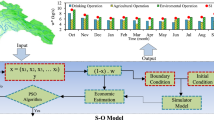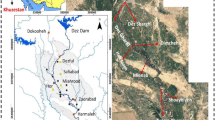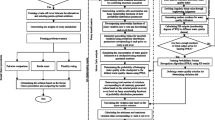Abstract
Model based decision support systems are increasingly used for the purpose of water resources management. In the aspect of water quality management, deterministic water quality simulation will involve various uncertainties that may yield unrealistic results. To overcome such limitations, this study proposed an optimization algorithm incorporating the stochastic approach focusing on efficient waste load allocation. Based on Monte Carlo Simulation (MCS) uncertainty analysis method, the performance of the chance constrained linear optimization programming was validated to describe the nonlinear behavior in the river system. Applicability of the proposed optimization scheme has been tested and evaluated for the Nakdong River basin in Korea where multiple pollutant sources and a large amount of water intake facilities coexist. The proposed optimization algorithm is useful to estimate the amount of waste loads that should be removed to meet the target regulatory water quality standard considering uncertainties involved in the deterministic water quality simulation.
Similar content being viewed by others
References
Beven, K. (2006). “A manifesto for the equifinality thesis.” Journal of Hydrology, Vol. 320, Nos. 1–2, pp. 18–36.
Brown, R. T. and Barnwell, T. O. (1987). The enhanced stream water quality model QUAL2E and QUAL2E-UNCAS, EPA/6003-87/007, U.S. EPA.
Chaudhry, M. H. (1993). Open channel flow, Prentice-Hall, pp. 133–137.
Datta, B. and Dhiman, S. D. (1996). “Chance-Constrained optimal monitoring network design for pollutants in ground water.” Journal of Water Resources Planning and Management, Vol. 122, No. 3, pp. 180–188.
Dennis, Jr., J. E. and More, J. J. (1977). “Quasi-newton methods, motivation and theory.” SIAM Rev., Vol. 19, No. 1, pp. 46–89.
Fujiwara, O., Gnanendran, S. K., and Ohgaki, S. (1987). “Chance constrained model for river water quality management.” Journal of Environmental Engineering, ASCE, Vol. 113, No. 5, pp. 1018–1031.
Han, K. Y., Choi, H. S., and Kim, S. H. (1999). “Analysis of water quality model uncertainty in the Nakdong River.” Proceedings 28th IAHR Congress, 22–27 August.
Han, K. Y., Kim, S. H., and Bae, D. H. (2001). “A stochastic water quality analysis using reliability methods.” Journal of American Water Resources Association, Vol. 37, No. 3, pp. 695–708.
Harmel, R. D. and Smith, P. K. (2007). “Consideration of measurement uncertainty in the evaluation of goodness-of-fit in hydrologic and water quality modeling.” Journal of Hydrology, Vol. 337, pp. 326–336.
Jacobs, T. L., Medina, M. A., and Ho, J. T. (1997). “Chance-Constrained model for storm-water design and rehabilitation.” Journal of Water Resources Planning and Management, Vol. 123, No. 3, pp. 163–168.
Kavetski, D., Franks, S. W., and Kuczera, G. (2002). “Confronting input uncertainty in environmental modelling.” Duan, Q., Gupta, H.V., Sorooshian, S., Rousseau, A.N. and Turcotte, R. (eds), Calibration of Watershed Models, AGU Water Science and Applications Series, Vol. 6, pp. 49–68.
Mays, L. W. and Tung, Y. K. (1992). Hydrosystems engineering and management, McGraw-Hill, Inc., New York, pp. 203–207.
Nakdong River Water Environment Laboratory (NRWEL) (2001). Generation and distribution of water pollutants for the streams in the Nakdong River basin (I), NIER No. 2001-35-627. (in Korean).
Nakdong River Water Environment Laboratory (NRWEL) (2002). Generation and distribution of water pollutants for the streams in the Nakdong River basin (II), NIER No. 2002-31-670. (in Korean).
Pappenberger, F. and Beven, K. J. (2006). “Ignorance is bliss: Or seven reasons not to use uncertainty analysis.” Water Resources Research, Vol. 42, W05302, doi:10.1029/2005WR004820.
Sawyer, C. S. and Lin, Y. F. (1998). “Mixed-Integer chance-constrained models for ground water remediation.” Journal of Water Resources Planning and Management, Vol. 124, No. 5, pp. 285–294.
Tung, Y. K. (1992). “Multiple-objective stochastic waste load allocation.” Water Resources Management, Vol. 6, No. 2, pp. 117–133.
Tung, Y. K. and Hathhorn, W. E. (1989). “Multiple-objective waste load allocation.” Water Resources Management, Vol. 3, No. 2, pp. 129–140.
Tung, Y. K. and Hathhorn, W. E. (1990). “Stochastic waste load allocation.” Ecological Modeling, Vol. 51, Nos. 1–2, pp. 29–46.
Vanderplaats, G. N. (1984). Numerical optimization techniques for engineering design: With applications, McGraw Hill.
Wurbs, R. A. and James, W. P. (2002). Water Resources Engineering, Prentice Hall, pp. 745–750.
Author information
Authors and Affiliations
Corresponding author
Rights and permissions
About this article
Cite this article
Han, K., Noh, J., Kim, JS. et al. Application of stochastic optimization algorithm for waste load allocation in the Nakdong River basin, Korea. KSCE J Civ Eng 16, 650–659 (2012). https://doi.org/10.1007/s12205-012-0919-8
Received:
Revised:
Accepted:
Published:
Issue Date:
DOI: https://doi.org/10.1007/s12205-012-0919-8




